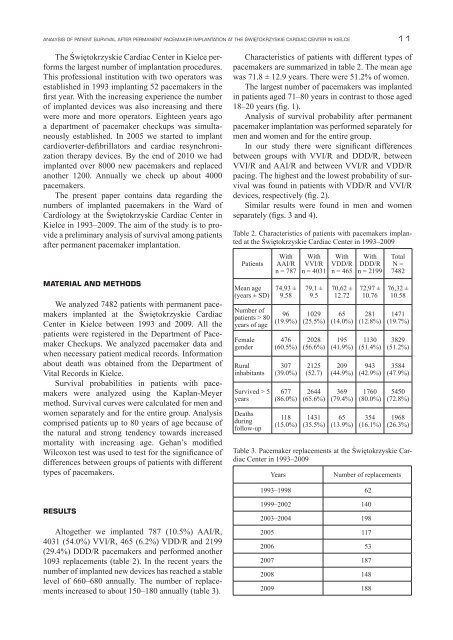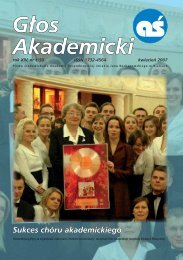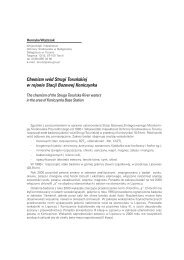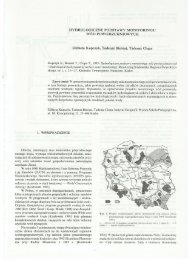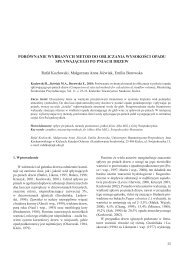25/2012 - Uniwersytet Jana Kochanowskiego w Kielcach
25/2012 - Uniwersytet Jana Kochanowskiego w Kielcach
25/2012 - Uniwersytet Jana Kochanowskiego w Kielcach
You also want an ePaper? Increase the reach of your titles
YUMPU automatically turns print PDFs into web optimized ePapers that Google loves.
ANALYSIS OF PATIENT SURVIVAL AFTER PERMANENT PACEMAKER IMPLANTATION AT THE ŚWIĘTOKRZYSKIE CARDIAC CENTER IN KIELCE<br />
The Świętokrzyskie Cardiac Center in Kielce performs<br />
the largest number of implantation procedures.<br />
This professional institution with two operators was<br />
established in 1993 implanting 52 pacemakers in the<br />
first year. With the increasing experience the number<br />
of implanted devices was also increasing and there<br />
were more and more operators. Eighteen years ago<br />
a department of pacemaker checkups was simultaneously<br />
established. In 2005 we started to implant<br />
cardioverter-defibrillators and cardiac resynchronization<br />
therapy devices. By the end of 2010 we had<br />
implanted over 8000 new pacemakers and replaced<br />
another 1200. Annually we check up about 4000<br />
pacemakers.<br />
The present paper contains data regarding the<br />
numbers of implanted pacemakers in the Ward of<br />
Cardiology at the Świętokrzyskie Cardiac Center in<br />
Kielce in 1993–2009. The aim of the study is to provide<br />
a preliminary analysis of survival among patients<br />
after permanent pacemaker implantation.<br />
MATERIAL AND METHODS<br />
We analyzed 7482 patients with permanent pacemakers<br />
implanted at the Świętokrzyskie Cardiac<br />
Center in Kielce between 1993 and 2009. All the<br />
patients were registered in the Department of Pacemaker<br />
Checkups. We analyzed pacemaker data and<br />
when necessary patient medical records. Information<br />
about death was obtained from the Department of<br />
Vital Records in Kielce.<br />
Survival probabilities in patients with pacemakers<br />
were analyzed using the Kaplan-Meyer<br />
method. Survival curves were calculated for men and<br />
women sepa rately and for the entire group. Analysis<br />
comprised patients up to 80 years of age because of<br />
the natural and strong tendency towards increased<br />
mortality with increasing age. Gehan’s modified<br />
Wilcoxon test was used to test for the significance of<br />
differences between groups of patients with different<br />
types of pacemakers.<br />
RESULTS<br />
Altogether we implanted 787 (10.5%) AAI/R,<br />
4031 (54.0%) VVI/R, 465 (6.2%) VDD/R and 2199<br />
(29.4%) DDD/R pacemakers and performed another<br />
1093 replacements (table 2). In the recent years the<br />
number of implanted new devices has reached a stable<br />
level of 660–680 annually. The number of replacements<br />
increased to about 150–180 annually (table 3).<br />
11<br />
Characteristics of patients with different types of<br />
pacemakers are summarized in table 2. The mean age<br />
was 71.8 ± 12.9 years. There were 51.2% of women.<br />
The largest number of pacemakers was implanted<br />
in patients aged 71–80 years in contrast to those aged<br />
18–20 years (fig. 1).<br />
Analysis of survival probability after permanent<br />
pacemaker implantation was performed separately for<br />
men and women and for the entire group.<br />
In our study there were significant differences<br />
between groups with VVI/R and DDD/R, between<br />
VVI/R and AAI/R and between VVI/R and VDD/R<br />
pacing. The highest and the lowest probability of survival<br />
was found in patients with VDD/R and VVI/R<br />
devices, respectively (fig. 2).<br />
Similar results were found in men and women<br />
separately (figs. 3 and 4).<br />
Table 2. Characteristics of patients with pacemakers implanted<br />
at the Świętokrzyskie Cardiac Center in 1993–2009<br />
Patients<br />
Mean age<br />
(years ± SD)<br />
Number of<br />
patients > 80<br />
years of age<br />
Female<br />
gender<br />
Rural<br />
inhabitants<br />
Survived > 5<br />
years<br />
Deaths<br />
during<br />
follow-up<br />
With<br />
AAI/R<br />
n = 787<br />
74,93 ±<br />
9.58<br />
96<br />
(19.9%)<br />
476<br />
(60.5%)<br />
307<br />
(39.0%)<br />
677<br />
(86.0%)<br />
118<br />
(15.0%)<br />
With<br />
VVI/R<br />
n = 4031<br />
79,1 ±<br />
9.5<br />
1029<br />
(<strong>25</strong>.5%)<br />
2028<br />
(56.6%)<br />
21<strong>25</strong><br />
(52.7)<br />
2644<br />
(65.6%)<br />
1431<br />
(35.5%)<br />
With<br />
VDD/R<br />
n = 465<br />
70,62 ±<br />
12.72<br />
65<br />
(14.0%)<br />
195<br />
(41.9%)<br />
209<br />
(44.9%)<br />
369<br />
(79.4%)<br />
65<br />
(13.9%)<br />
With<br />
DDD/R<br />
n = 2199<br />
72,97 ±<br />
10.76<br />
281<br />
(12.8%)<br />
1130<br />
(51.4%)<br />
943<br />
(42.9%)<br />
1760<br />
(80.0%)<br />
354<br />
(16.1%)<br />
Total<br />
N =<br />
7482<br />
76,32 ±<br />
10.58<br />
1471<br />
(19.7%)<br />
3829<br />
(51.2%)<br />
3584<br />
(47.9%)<br />
5450<br />
(72.8%)<br />
1968<br />
(26.3%)<br />
Table 3. Pacemaker replacements at the Świętokrzyskie Cardiac<br />
Center in 1993–2009<br />
Years Number of replacements<br />
1993–1998 62<br />
1999–2002 140<br />
2003–2004 198<br />
2005 117<br />
2006 53<br />
2007 187<br />
2008 148<br />
2009 188


